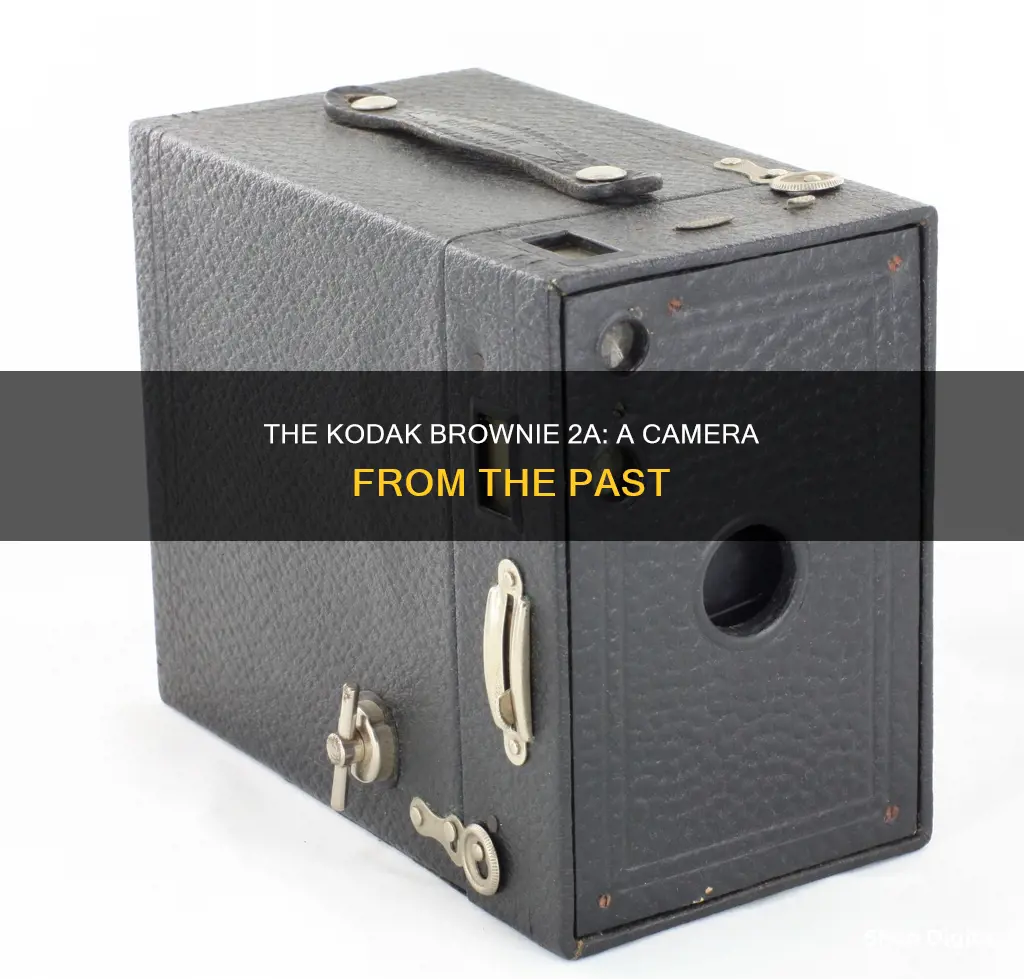
The Kodak Brownie was a series of camera models first released in 1900, with the No.2 Brownie introduced in 1901. The No.2A Brownie, introduced in 1907, was a box camera that used 116 film and was manufactured until 1933. The body was initially made of cardboard, but after 1924, Kodak switched to an aluminium chassis. The No.2A Brownie featured a rotary shutter and two viewfinder windows, and produced large postcard-size negatives. Over 2,100,000 units were made before 1921, and it retailed for $3.00.
| Characteristics | Values |
|---|---|
| Introduction | April 1907 |
| Discontinuation | 1936 |
| Film size | 116 |
| Picture size | 2 1/2 X 4 1/4" |
| Manufacture locations | US, Canada, UK |
| Manufacture dates | 1930-1936 |
| Lens | Meniscus |
| Shutter | Rotary |
| Number manufactured | Over 2,100,000 before 1921 |
| Original price | $3.00 |
| Aluminum model (US) | $3.75 |
| Color models (US) | $4.00 |
| Color models (UK) | <co: 1>? |
What You'll Learn

The Kodak Brownie No. 2A was introduced in 1907
The Kodak Brownie No. 2A was introduced in April 1907. It was a box camera that used 116 film. The camera was manufactured until 1933, with over 2,100,000 units made before 1921. Initially, the body was made of cardboard, but Kodak switched to an aluminium chassis after 1924. The Kodak Brownie No. 2A had a rotary shutter activated by a lever on the right side of the camera and featured a single shutter speed of approximately 1/25th of a second.
The camera produced large "postcard-size" negatives, measuring 2 1/2 X 4 1/4 inches, perfect for contact printing. This feature contributed to the popularity of the Kodak Brownie No. 2A, as it put the "Postcard Photographers" of early-day resorts, such as Coney Island and Atlantic City, out of business. The large negative size also allowed for good results under the right conditions, making it appealing to a broader audience than just children, who were its initial target market.
The Kodak Brownie No. 2A featured two metal tabs on top that controlled various settings. The wider tab adjusted the aperture with options of f/8, f/11, and f/16, while the smaller tab selected either the regular shutter speed or "B" (bulb), allowing for an indefinite shutter opening duration. The camera also included a red safety window at the back to view the frame number.
The Kodak Brownie No. 2A played a significant role in democratising photography by addressing cost factors, making it accessible to everyday people. Its simple design, ease of use, and affordable price, along with the low-cost Kodak roll film and processing, contributed to its success and impact on the photography landscape.
Is Your Eufy Camera Charging? Check This Way
You may want to see also

It was manufactured until 1933 or 1936
The Kodak Brownie was a series of camera models first released in 1900. The No.2A Brownie, introduced in 1907, was manufactured until 1933 or 1936.
The No.2A Brownie was a box camera that used 116 film. Initially, the body was made of cardboard, but from 1924, Kodak switched to an aluminium chassis. The camera featured a rotary shutter, activated by a lever on the right side, and a single shutter speed of approximately 1/25th of a second. It had two viewfinder windows, one for portrait and one for landscape orientation, and two metal tabs on top for adjusting the aperture and shutter settings. The film was advanced using a winding key on the lower right side.
The No.2A Brownie was extremely popular, with over 2,100,000 units produced before 1921. It was known for its ability to produce "postcard"-size negatives, perfect for contact printing. This feature contributed to the demise of "Postcard Photographers" at early-day resorts.
The No.2A Brownie underwent several variations during its production run. In 1909, eyelets were added to the lens and finder windows, and in 1911, the Model B was introduced with internal changes to the lens board. In 1917, improvements were made to the film tension springs and case latches, and a metal nameplate was added to the back. From 1924 onwards, the camera's body was made of metal instead of cardboard.
The No.2A Brownie played a significant role in democratising photography by making it accessible to the masses. With its simple design, affordable price, and good results, it left a lasting impact on the world of photography.
Charging Your Eufy Camera Battery: A Step-by-Step Guide
You may want to see also

The original price was $3
The Kodak Brownie was first released in 1900, with the No.2A Brownie introduced in 1907. The original price of the No.2A Brownie was $3.00, with the aluminum model priced at $3.75 and the colour models at $4.00 in the US. The No.2A Brownie was a hugely popular camera, with over 2,100,000 units manufactured before 1921.
The low price of the Kodak Brownie, along with the affordable cost of Kodak roll film and processing, made amateur photography accessible to the masses. The Brownie was a basic cardboard box camera with a simple lens that took 2+1⁄4-inch square pictures on No. 117 roll film. The initial price of the original Brownie was just $1 (equivalent to $37 in 2023).
The No.2A Brownie had several features that improved its performance and ease of use. It used 116 film and produced 2 1/2 X 4 1/4" images. The camera had a rotary shutter activated by a lever on the right side and a single shutter speed of approximately 1/25th of a second. The aperture could be adjusted using the metal tabs on top of the camera, and the shutter speed could be changed between regular and "B" (bulb) mode. The No.2A Brownie also featured two viewfinder windows, one for portrait and one for landscape orientation.
The No.2A Brownie underwent several variations and improvements during its production run. In 1909, eyelets were added to the lens and finder windows, and in 1911, the Model B was introduced with internal changes to the lens board. In 1917, improvements were made to the case latches, and a metal nameplate was added to the back. In 1920, a trigger guard was included, and in 1924, the card construction of the camera was replaced by metal.
The Kodak Brownie played a significant role in democratising photography and became ubiquitous, with many iconic shots taken using these cameras. It spawned various models and remained popular for decades, with the last official Brownie camera made in 1986.
Simplisafe Doorbell Camera: Charging Simplified
You may want to see also

The body was initially made of cardboard, then aluminium after 1924
The Kodak Brownie was a series of camera models first released in 1900. The No.2 Brownie, introduced in 1901, was initially made of cardboard covered in leatherette. This model was replaced by the No.2A Brownie in 1907, which was also made of cardboard.
In 1924, Kodak switched to an aluminium chassis for the No.2A Brownie, although the No.2 Brownie continued to be made of cardboard until 1928, when it too switched to a metal body. The No.2 Brownie was discontinued in 1935, while the No.2A Brownie continued to be manufactured until 1933.
The No.2 Brownie was a significant camera as it was the first to use 120 roll film. It was a very simple camera with a dependable shutter. It had two sliding mechanisms on the top, one for the bulb or time setting, and the other for choosing between three apertures. It also featured two small reflecting finders for vertical or horizontal shots.
The No.2A Brownie was also a very popular camera. It used #116 film and produced a large "postcard" size negative, which was perfect for contact printing. This helped put the "Postcard Photographers" of early-day resorts, like Coney Island and Atlantic City, out of business.
The Camera Obscura: Unveiling Its Intriguing Components
You may want to see also

More than 2,100,000 were made before 1921
The Kodak Brownie was a series of camera models first released in 1900. The No.2A Brownie model was introduced in April 1907 and was manufactured until 1933 or 1936. The No.2A Brownie was extremely popular, with over 2,100,000 made before 1921.
The No.2A Brownie was a box camera that used 116 film. Initially, the body was made of cardboard, but after 1924, Kodak switched to an aluminium chassis. The camera featured a rotary shutter activated by a lever on the right side of the camera, with one fixed shutter speed of approximately 1/25th of a second. It had two viewfinder windows, one for portrait shots and one for landscape images. The film was advanced using a winding key on the lower right side.
The No.2A Brownie was an affordable option for amateur photographers, with an original price of $3.00 for the aluminium model and $3.75 for the colour model in the US. The camera's simplicity and low cost made it widely accessible, and its popularity led to the production of various models and variations.
The No.2A Brownie played a significant role in democratising photography. Its release addressed the cost factor that had previously made amateur photography unaffordable for many. With its simple controls and low-cost film and processing, the No.2A Brownie surpassed its marketing goals, appealing to a broad range of consumers beyond its initial target audience of children.
The camera's large "postcard" size negatives were perfect for contact printing, and its durability and ease of use contributed to its enduring popularity. The No.2A Brownie's impact extended beyond casual photography, with iconic shots taken on these cameras, including Bernice Palmer's photographs of the iceberg that sank the RMS Titanic in 1912.
Converting Camera Raw Files to JPEGs: A Step-by-Step Guide
You may want to see also
Frequently asked questions
The Kodak Brownie Model 2A was introduced in 1907 and manufactured until 1933 or 1936.
The Kodak Brownie Model 2A is a box camera that uses 116 film. It has a rotary shutter and a single element, meniscus lens. The image size is 2 1/2 X 4 1/4 inches.
The original price of the camera was $3.00. The aluminum model cost $3.75, and the color models cost $4.00 in the US.
There were several variations of the Kodak Brownie Model 2A released over time. In 1909, eyelets were fitted to the lens and finder windows. In 1911, the Model B was introduced with internal changes to the lens board. In 1917, film tension springs were moved from the center to the spool ends, and the case latches were improved. A metal nameplate was added to the back of the camera in 1918, and a trigger guard was fitted in 1920. In 1924, the Model C was introduced with an aluminum body, tripod sockets, and a hinged back with a spring latch.







